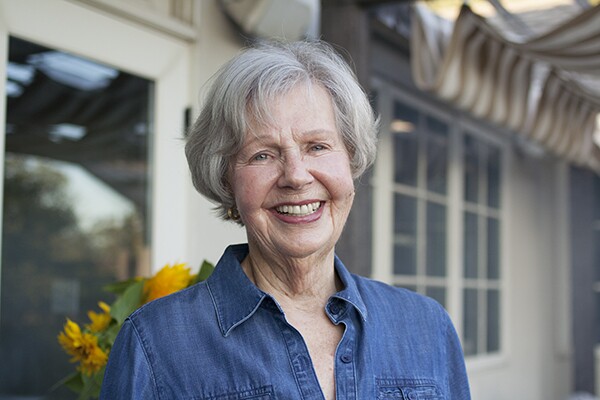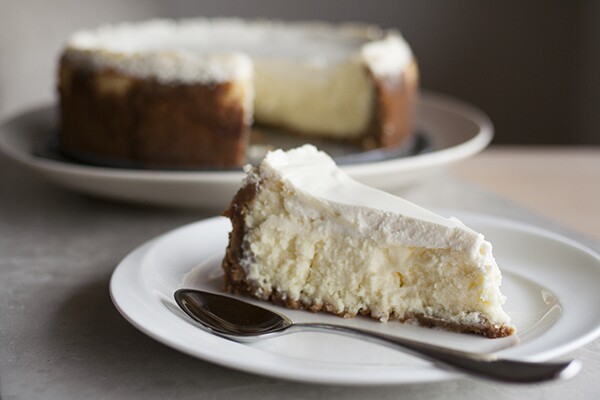Cooking with Grandparents: Nancy Collins' Cheesecake

Nancy Collins found this cheesecake recipe in Gourmet magazine some thirty years ago. Over time she modified it to make it her own, adding more graham cracker crumbs for a thicker crust and adjusting the size of the pan. "Back then the recipes in cooking magazines were more complicated than what you might find today," Nancy says. "They were longer, had more steps and more elaborate techniques, but for the most part they were worth the effort."
Cheesecake quickly became her family's favorite dessert, so Nancy cooked her version for birthdays, holidays, and even regular weekdays. One year at Christmastime, her husband's entire family came over for dinner and Nancy prepared this cheesecake for dessert, but when her husband went to go retrieve it from the fridge, he accidentally dropped the cheesecake on the floor.
"He felt awful," she said. Anyone would, although it's especially clear how awful one might feel after you try a bite of Nancy's cheesecake. One of the secrets, she says, is to beat the cream cheese filling until it is really fluffy.
Cooking was Nancy's creative outlet for most of her adult life. "I needed it," she says. Nancy was a third-year student in the art and architecture department at the University of Michigan when she got married and had to move to Cambridge, Massachusetts. At fifty-one, she went back to school to complete her Bachelor of Fine Arts. She is not only a talented cook but also an accomplished seamstress--she sewed her own maternity clothes, stitched curtains, and even smocked her children's clothing.
"You want to know how I learned to cook?" she asked, then paused for emphasis. "Thank you, Julia Child!"

Nancy Collins' Cheesecake
Some cheesecake recipes call for baking the cake in a water bath, which helps to evenly distribute the heat of the oven, but Nancy's cheesecake doesn't need it. Her recipe does, however, rely on the ease of a springform pan. Once the cheesecake has baked and cooled, the sides of the pan can be popped off, revealing an intact graham cracker crust. It can then be easily sliced. If you don't have a springform pan, a regular pan with tall sides will do--the cheesecake will still taste great, though the slices might not look quite as lovely.
Serves 14 - 16
2 cups finely ground graham crackers
8 tablespoons (1 stick) unsalted butter, melted
2 cups granulated sugar
24 ounces cream cheese, softened to room temperature
1/8 teaspoon salt
2 teaspoons pure vanilla extract
4 large eggs, warmed to room temperature
2 cups sour cream
Preheat the oven to 350°F.
In a medium bowl, stir together the graham cracker crumbs, melted butter, and ¼ cup of the sugar. Transfer crumb mixture to a 9-inch springform pan and press it evenly into the bottom and sides of the pan. Place the pan in the fridge to chill for about 10 minutes.
Meanwhile, whip the cream cheese in a stand mixer fitted with the paddle attachment on medium-high speed until it is fluffy, about 3 minutes. Gradually mix in the salt, 1 teaspoon of the vanilla, and 1½ cups of the sugar. Continue mixing until the sugar is fully dissolved, about 5 minutes more. Add the eggs, one at a time, beating well after each addition.
Pour the cream cheese mixture into the chilled crust. Bake for 50 minutes, until barely golden brown and set. Remove the cake from the oven, increase the oven temperature to 450°F, and let the cake cool for 15 minutes.
Meanwhile, whisk together the sour cream, remaining 1 teaspoon of the vanilla, and remaining ¼ cup of the sugar. When the cake has cooled, spread the sour cream mixture evenly across the top of the cake. Bake for 10 minutes, then let the cheesecake cool at room temperature, and chill it overnight in the refrigerator.
To serve, remove side of springform pan and cut the cheesecake into slices, dipping your knife into very hot water between each cut.
(Once the cheesecake has chilled completely, it can be frozen, tightly sealed, for months.)



